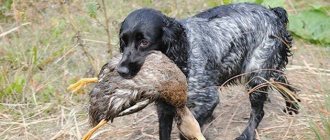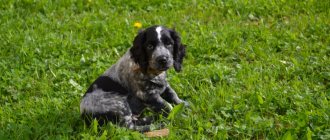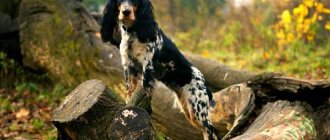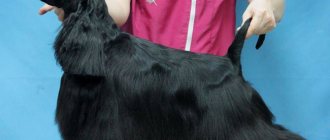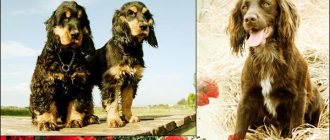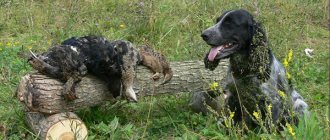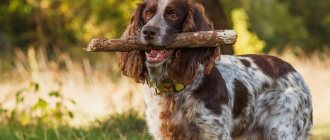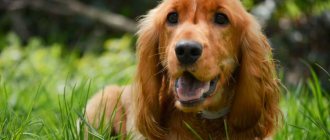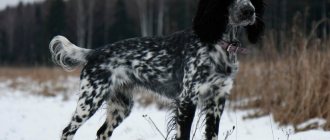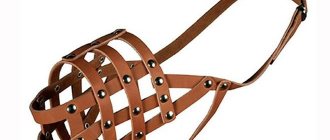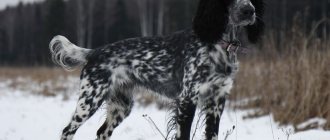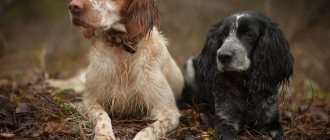The Russian Hunting Spaniel (ROS) is the only national breed of gun dog. These are loyal, flexible and friendly animals. They love an active life and always strive to show their hunting qualities. Therefore, when training Russian hunting spaniels, it is important to take this feature into account, even if the owner is not a fan of hunting.
Origin of the breed
In the 19th century, the favorite pastime of the Russian tsars was hunting; fabulous amounts of money were spent on the selection and maintenance of hunting dogs. Working hunting dogs were presented as expensive gifts from European monarchs to the rulers of Russian lands. With the advent of the English Cocker Spaniel in Russia, connoisseurs of elite hunting have become increasingly interested in game birds. But the short-legged, aristocratic English dog could not move with sufficient speed through the weeds and ravines of central Russia.
Interesting! The history of the breed is rooted in the creation of the English Cocker Spaniel breed, the Springer Spaniel and the desire of hunters to obtain a universal working dog for game birds.
By crossing various spaniels (mainly English and Springer), it was possible to obtain a relatively uniform dog.
Purposeful breeding work began in 1927 in St. Petersburg. In 1945, Moscow became interested in the new species, and a club for breed lovers appeared. In 1949, intensive work began on developing a new domestic breed - the Russian hunting spaniel. The official birthday of the breed is 1951, the first standard was drawn up and a stud book was opened. Since 1972, the Russian Spaniel has completely stopped mixing genetic codes of other breeds.
Interesting! The Russian Hunting Spaniel is not recognized by the International Canine Federation.
Related breeds
The closest relatives of the Russian spaniel are the American and English cocker spaniels, but the difference between them is not only in color and coat type, but also in hunting instincts and constitution.
English cocker spaniel
The domestic spaniel differs from the English cocker in the shape of the skull and body. The Russian has longer legs and a more extended format. The English spaniel is more squat and stocky. Visually, the ROS looks small and light, but is not inferior in endurance and performance. The English “relatives” are not so willing to fetch game from the water, but they are not inferior in flair and thirst for hunting.
American Cocker Spaniel
The American Cocker Spaniel has a more aristocratic appearance compared to its prototypes, with clear lines of the head and back, and more abundant hair. He is inferior in height and weight, although he is just as active and hardy. Working American Cockers can be practically counted on one hand due to their aesthetic beauty. Increasingly, Americans meet at exhibitions rather than hunting.
Bathing
To keep your dog clean, it is not necessary to bathe it every time it gets dirty.
It is enough to brush regularly with a soft brush. If you bathe frequently using detergents, your dog may experience itchy skin and flaking. Shampoo and soap destroy the fat layer, which naturally protects the skin from dirt and moisture. This is especially true for puppies under six months of age. You can bathe your puppy using homemade shampoo, consisting of kefir or curdled milk, egg yolk and warm water. This composition will not damage the protective layer. If the pet is dirty and the dirt cannot be washed off with a home remedy, then shampoo for long-haired dogs is used. It is diluted with warm water in a 1:1 ratio.
Paws and ears are washed every time you return to the house. The puppy must be taught this procedure from an early age.
Description and breed standard
A brief description of the breed is presented in the table:
| Short description | |
| Origin | Russia |
| Conditions of detention | Private house or apartment |
| Purpose | Hunting, gun, companion |
| Color | Solid, bicolor piebald, tricolor, with tan |
| Wool length | Middle length |
| Adult dog size | Height 36–44 cm, weight up to 20 kg |
| average life expectancy | 12–15 years |
| Walk | Mandatory, from 2 times a day |
| Need for physical activity | High demand - from 2 hours a day |
| Classification of the International Canine Federation (FIC) | Not recognized by the IFF |
| Puppy cost | From 5 thousand rubles to 20 thousand, depending on the pedigree and working qualities of the parents |
Description of parameters:
- General form. A compact, squat dog with a slightly stretched format. Strong, with good muscles.
- Head. Relative to the small size of the body, the transition from the forehead to the muzzle is pronounced, but not strongly, the occipital protuberance is weakly expressed. Scissor bite, full set of 42 teeth. The ears are hanging, located at eye level or slightly higher, the length of the ear reaches the nose. The eyes are symmetrically located, dark brown in color, not too prominent. The nose and rims of the eyelids are ideally black; in red colours, pigmentation to match the color of the coat is allowed. The lips are dry, fit tightly to the jaw, jowls cover the lower jaw.
- Neck. Set relatively low, with slight dewlap, strong, with well-developed muscles.
- Frame. Stretched format (stretch index - 110–120%). The chest is wide and deep, reaching to the elbow joint. The back is straight, the withers are well defined, the loin is short and muscular. The croup is quite sloping.
- Limbs. Straight, strong, parallel to each other, with good articulation angles. The hind legs are very muscular, the toes are arched. Pasterns without markings. The length of the front legs is equal to half the height at the withers.
- Tail. Located on the line of the back, held no higher than its level. In working dogs it stops after the fourth vertebra.
- Sexual dimorphism is pronounced. Its presence is encouraged, but females of the male type are not disqualified.
Congenital characteristics for disqualifying a dog:
- too large or small in height (dwarf) and weight of the stated standard;
- too aggressive;
- shorthaired or mongrel haired;
- solid white color;
- presence of malocclusion;
- mixed breeds with other spaniel groups;
- erect or short ears.
Coat and color
The guard coat of the Russian Spaniel is of medium length and coarse, lying close to the body, slightly wavy, but without curls. Longer on the stomach, ears, and paws than throughout the entire body. There is practically no undercoat. Due to the lack of undercoat and tight-fitting outer coat, the dog looks almost smooth-haired.
There are three varieties of colors:
- solid;
- two-color;
- tricolor.
Solid color can be: black, red, brown (chocolate). With all solid colors, white markings on the chest, paws, and tail are acceptable. Red can be any shade - from golden to reddish.
There are two-color ones: black and white, red and white, brown and white. Two-tone colors are also called piebald or harlequin.
Tri-color colors include solid black or brown with white markings and red tan, or piebald with black and tan markings on a white background.
Weight and height
The preferred height at the withers for males is 40 centimeters (+-2 cm), for females - 38 centimeters (+-2 cm). An adult male ideally should not weigh more than 20 kilograms, a female - more than 17.
It is important to know! Height and weight parameters are relative. The main thing is that the dog looks organic for its size and does not have excess weight. The exterior can only be fully assessed on a fully formed individual. Russian spaniels grow until they are 18 months old.
Breed characteristics
The Spaniel's personality is suitable for any person. Representatives of the breed get along well in families with children and single people, with experienced or novice hunters. Not suitable only for lazy people - the spaniel is too energetic.
He has a lively, playful disposition and behaves like a puppy until old age. Ready to follow the owner with its tail, wanting to attract attention. At the same time, it lends itself well to training and has remarkable endurance. Not prone to dominance, gets along well in a pack of several dogs.
It has excellent innate hunting qualities. Easily learns to retrieve ducks from the water and search for wounded birds. You can train to follow a blood trail, follow a hare, or even use a dog for fishing. The spaniel is more obedient than the husky, but is no less comfortable and hardy in hunting. It will not be difficult even for a novice hunter to develop a ROS into a universal hunting assistant.
Despite the versatility of the spaniel, we must not forget that, first of all, it is a gun dog. Its true purpose is to lift the bird on its wing. But the breed allows you to choose who to hunt.
Features of character and behavior
The Russian Spaniel is an excellent pet and companion. He is active, friendly and devoted to his owner. The breed has not lost its hunting qualities and still serves people.
These dogs are characterized by intelligence and ingenuity, independence in decision-making, good reaction, and endurance. All these qualities become indispensable in the forest.
Advantages
The breed was bred for hunting, so it has a full range of necessary physical qualities:
- Acute vision and sense of smell;
- Energy;
- Endurance;
- Resistance to cold and dampness;
- Strong skeleton and developed muscles.
Animals learn quickly and understand all commands.
Russian spaniels love their family, get along with children, and listen to their owner. They will be happy to serve a person, spend all their time with him: lying on the couch or climbing into a cold swamp. They like to run with their owner, play with family members, and bring toys. These dogs are very active and remain playful almost into old age.
They get along well with other pets and livestock. They communicate well with both dogs and cats, despite the fact that they are hunters.
Flaws
- Spaniels can be stubborn, intractable, and often try to dominate.
- They really need good upbringing and a firm hand, otherwise they will grow up to be an uncontrollable pet.
- They are real destroyers: they love to gnaw, break, tear, scratch. Everything that lies badly will be picked up, studied and spoiled by this pet.
- They cannot serve as guards. Representatives of the breed are friendly and do not see danger in humans. Besides that, they just bark.
- They are gluttonous and have no sense of proportion. This makes walking much more difficult. If the bad habit of picking up from the ground was not eliminated during puppyhood, then you can forget about walking without a leash.
- They can be aggressive towards other people's children and do not like noise, shouting and bullying.
Maintenance and care
Spaniels are not suitable for keeping in a kennel; the lack of undercoat does not allow them to feel good outside all winter. The ideal housing option is a private house, but with appropriate walking, you can keep a Russian hunter even in a small apartment.
Walks
Spaniels are very active dogs with a strong hunting instinct. They can cause trouble within the city, because they love to chase pigeons and other birds not suitable for hunting. This behavior must be stopped by methodically raising the dog, showing it the boundaries of what is permitted.
For long walks outside in winter or in very bad weather, it is recommended to use special protective clothing: raincoats and overalls for dogs. It is not advisable to toilet train at home - the animal is too active, and without a long walk it can exhibit destructive behavior.
Combing and cutting
The absence of a thick undercoat allows you to do without grueling daily combing. But dead guard hair needs to be removed about once a week. During the molting period - 2-3 times in 7 days. You need to use a fine-tooth comb or a furminator.
Working dogs receive exclusively hygienic haircuts. The hair is trimmed between the paw pads and around the anus. In order for the dog not to freeze while hunting, there is no need to cut it anymore, although after running through weeds and bushes, the appearance of the coat will have to be brought back to normal.
Cleaning ears and teeth
The ears and teeth of a completely healthy dog do not cause much trouble. You can take care of your teeth using special toothpastes and brushes designed for pets. Cleaning at home should be done no more than 2 times a month. Pets with dental problems tend to develop tartar every week. It is recommended to have the mouth examined by a veterinary dentist twice a year.
A healthy spaniel's ears do not require special attention. Cleaning can be done as the ear gets dirty (1-2 times a month), but you need to constantly monitor the condition of your ears. Working dogs are prone to infection with ixodid and ear mites, which lead to inflammatory processes in the body.
Antiparasitic treatment
Treatment for ectoparasites and helminths is very important for working spaniels. The hunting season coincides with the time of active hunting of the ixodid tick and it is not difficult to become infected with worms in the wild.
Preventive treatments against helminths are carried out at least once every 3 months. If the dog is infested, the procedure must be repeated after 10–14 days. It is more expedient to treat animals living in a flock at the same time.
Prevention of ectoparasites is carried out according to the instructions of the selected method. The choice of antiparasitic drug is up to the dog owner, depending on the pet’s individual tolerance and the owner’s financial capabilities. Each product has its own pros and cons, and it is up to the owner to decide which one to use.
Grooming
Grooming is a must, as long hair can be not only a decoration, but also a source of additional problems. Haircuts should be done regularly to prevent the formation of tangles. The owner himself decides how to trim the pet; attention is paid to the places with the longest hair - ears, pants, etc. Also, caring for the dog’s coat includes regular brushing of the dog, combing out tangles that have managed to form. During molting, it should be daily. It is necessary to bathe your spaniel when it gets dirty; sometimes it is better to wash the ears separately. Be sure to use a special shampoo.
Breed diseases
The Russian Hunting Spaniel is a healthy breed, but there is a tendency for some diseases. Among them:
- otitis;
- obesity (prone to overeating);
- allergy;
- lacrimation.
By knowing breed predispositions, all diseases can be prevented. To do this, it is enough to monitor the quality, volume and diet, condition of the ears and eyes.
How long Russian spaniels live depends directly on their state of health. The average life expectancy is 12–15 years.
Vaccinations
Immunization of domestic animals against rabies is required by law. Vaccinations against all other viral infections are done at the discretion of the owner. But for working dogs, vaccination is a necessary procedure, since wild animals are carriers of viral diseases, including rabies.
Important! Veterinary institutions have the right to refuse admission if the dog is without a muzzle, no matter how kind it may be.
When to get the first and subsequent vaccinations, what types of viruses there are - find out from the table
| Age | Diseases | Notes |
| 6 – 10 weeks | Parvovirus enteritisLeptospirosisCarnivore plagueInfectious hepatitis | First vaccination |
| 10 – 14 weeks | Parvovirus enteritisLeptospirosisCarnivore plagueInfectious hepatitis | Revaccination |
| 10 – 14 weeks | Rabies | The first immunization, if the puppy is kept in a greenhouse, can be postponed until the change of teeth |
| 10–12 months | Parvovirus enteritisLeptospirosisCarnivore plagueInfectious hepatitis | Last puppy vaccination, repeated every year |
| 10 – 12 months | Rabies | Last puppy vaccination, repeated every year |
Adult dogs are vaccinated once a year, often using a complex vaccine against rabies and other common viruses. Before each immunization, it is necessary to carry out helminth prophylaxis.
Health and treatment
Purebred Russian spaniels are considered fairly healthy dogs, but they are also prone to certain diseases.
Common diseases:
- Otitis.
- Obesity. This disease usually develops in Russian spaniels in case of overeating and lack of necessary physical activity.
- Leptospirosis. Dogs should be vaccinated against this deadly disease annually. Unvaccinated dogs swimming in ponds with stagnant water can contract Leptospira, the parasitic bacterium that causes this disease.
- Food allergies.
- Demodecosis.
- Inflammation of the anal glands.
In any case, if you suspect any disease, you cannot treat your pet yourself. You should show your Russian Spaniel to a veterinarian as soon as possible, who will make the correct diagnosis, do tests and provide competent treatment.
The average lifespan of Russian spaniels is 14–15 years, but with good care, some individuals can live up to 20 years.
The owners of the Russian Spaniel can be proud that they have one of the most loyal, intelligent and obedient dogs in their home.
Then you just need to love, follow the rules of care and maintenance, raise, train and treat your pet in a timely manner. Only in this case will he be guaranteed a long and happy life.
Nutrition for puppies and adult dogs
Regardless of the owner’s decision on what to feed his dog, natural or dry food, it is necessary to follow the feeding regime. Adults, whatever the breed, need to be fed no more than 2 times a day.
It is difficult to choose a complete diet, rich in all the substances necessary for health, on your own. Therefore, many owners increasingly prefer industrial ready-made food.
Puppies' diet by month:
- Newborns - 1 month. The mother of the puppies monitors the feeding regime.
- 2 months. The breeder begins to feed the babies 2-4 times a day, depending on the number of puppies and the bitch’s ability to feed them.
- 3–4 months. Puppies are fed small portions every 3 hours, 6 times a day.
- 4–6 months. The interval between feedings and portion size are increased, food is given 4 times a day.
- 6–10 months. Teenagers are served breakfast, lunch and dinner.
- 10–12 months. You can gradually approach the regime of an adult dog - 2 times a day.
How to organize a walk
The owner must remember that a spaniel living in an apartment needs to be walked twice a day. First of all, to cope with natural needs, and secondly, to release accumulated energy. A dog that will not have the opportunity to run outside will spend its unspent energy at home. This will manifest itself in damage to furniture, clothing, shoes and other personal belongings of the owner.
The total duration of the spaniel's stay on the street is at least 3 hours. During walks, the dog should be physically active. You can and should take your pet with you for a run or a bike ride. The best place for this would be a park or forest. In busy places, you should not let your pet off the leash.
How to choose a puppy
Before you go for a puppy, you need to study its pedigree and talk with the breeder about the working instincts of the parents. Breeders and nursery owners are willing to make contact with the future owners of their charges. If you travel far, you can ask to send a photo or video of both parents and the babies themselves to assess their condition. An obvious breed defect is noticeable even in photographs.
You should not buy puppies from dogs whose breed is in doubt, or if they are kept in poor conditions (on a chain, in a kennel on the street). It is impossible to predict how developed the hunting instinct is in such individuals. Parents who are kept in terrible conditions often have a huge number of genetic and acquired diseases. Caring for a puppy from such breeders can be expensive, troublesome, and ultimately futile.
Preparing for the arrival of a puppy
Before a little Russian spaniel crosses the threshold of a new home, it is necessary to thoroughly prepare the premises for this important event.
There are some recommendations that will help novice dog breeders provide competent care and safe maintenance for their new four-legged family member:
- All wires, small objects, household chemicals, and plants should be removed from the puppy’s reach.
- Outdoor shoes pose a danger to an unvaccinated baby, as they can contain a huge number of viruses, and sometimes helminth eggs. From the moment the dog appears in the house, shoes should be stored in special shoe racks. It is also advisable to put house slippers on a higher shelf.
- When keeping a puppy in an apartment on the day of his move, it is advisable to carry out a general cleaning using disinfectants, which must be thoroughly rinsed off.
- The necessary accessories for caring for a spaniel puppy are purchased in advance: a bed, bowls, disposable diapers, a leash, a collar, toys.
- It is advisable to choose bowls with height adjustment so that as the puppy grows they can be raised higher.
- Toys for a Russian Spaniel puppy should not have small or easily detachable parts that the pet can swallow. It is best that these are latex or rubber toys that do not spoil, as well as rope cords.
- You should ask the breeder in advance what kind of food the puppy is used to. The baby should be fed this food for the first 2–3 weeks.
- The place for the Russian Spaniel puppy should be in a secluded corner, located away from heating devices, drafts, audio and climate systems. At the same time, the baby should be able to see the entire room. It is better to place absorbent diapers, as well as food and water bowls in close proximity to the puppy’s bed.
- It is recommended to purchase a special playpen or safety gate for the doorway. This will help the baby quickly adapt to the new home, and will also protect against accidents that can happen when the pet is left alone at home.
- The flooring in the room where the puppy will live should be non-slippery. Otherwise he may get injured.
Nicknames for Russian Spaniel
The choice of a nickname for a working dog should be primarily aimed not at aesthetics, but at how the dog will remember it and respond to it. The nickname should be clear, short, and sonorous. You should avoid words that are difficult to pronounce or too long - it may be difficult to call when hunting.
For boys
Suitable names for spaniel boys:
- Robie;
- Roy;
- Rudy;
- Barney;
- Raf;
- Oscar;
- Roni;
- Kai;
- Kevin;
- Radar;
- Noah;
- Ren;
- Eric;
- Hoshi.
For girls
Suitable nicknames for girls spaniels:
- Molly;
- Dolly;
- Lucky;
- Laura;
- Dory;
- Nika;
- Mary;
- Boni;
- Lika;
- Sparta;
- Bullet;
- Puma;
- Us;
- Whiskey.
Education and training
Russian spaniels are diligent students, especially when it comes to learning how to hunt game. The innate desire to search for and raise a bird is so strong that special training is often not needed. With systematic training to find and retrieve birds, the spaniel will become a universal hunter.
How to train, how many commands to study - this must be decided by the owner from the moment the puppy arrives at home. You can train a spaniel in basic obedience at home, without the help of specialists.
It is important to know! The main thing is to be consistent, methodical, calm. Before starting training, you need to decide: what a dog needs to know in order to become comfortable and useful for the owner.
Estrus, mating and pregnancy
Owners of females not intended for breeding are recommended to undergo complete castration before the first heat. This will save you from many problems during collective hunting and hormonal imbalances in the body. Owners of bitches with breeding value need to understand that during estrus and pregnancy the dog will fall out of heat.
Estrus occurs during puberty - from 6 to 11 months, depending on the characteristics of the body. Mating is allowed to be planned no earlier than the third heat or upon reaching the age of 18 months. The male is looked for in advance, and the female is taken to the male’s territory for mating on the 10th–15th day of estrus. A veterinarian can predict a good day for mating after examining a female dog in heat. Females remain pregnant for 56–64 days.
How to clean eyes, teeth, ears and claws
The Russian Spaniel's eyes need to be washed daily. If the discharge is wet, remove it with a napkin. Dry crusts must first be soaked. You should not wash your eyes with tea or boric acid. A dog with watery or pus-filled eyes should be seen by a veterinarian.
To care for your pet's teeth, you need to purchase a special toothpaste and brush. Tablets and sprays with menthol, which destroy bacteria, are also suitable for these purposes. If a piece of food is stuck between your teeth, you can remove it with tweezers.
Spaniels' ears also require regular care, as wax and dirt accumulate in them. Veterinarians recommend plucking out too long hairs growing in the ears. It would be a good idea to lubricate the inside of the ear with vegetable oil.
The claws are trimmed for those spaniels who do not have the ability to grind them down themselves. This is necessary to ensure that the dog does not experience discomfort while walking or running.
Both the puppy and the adult Russian Spaniel require regular examinations by a veterinarian. You should also not leave your dog unvaccinated. Timely vaccination will help avoid many dog health problems.
Source
Hunting with a Russian Spaniel
With the Russian Hunting Spaniel, hunting turns into an exciting sporting competition. This is the best gun dog - it does not leave the hunter, flawlessly carries out commands, and does not drive the game too far.
With a Russian Spaniel you can go hunting for any type of game birds or small furs. This breed is excellent for searching for wounded animals or holes, following a blood trail. ROS can not only lift a bird under a shot, but also bring it back to the hunter. It is noteworthy: spaniels get excited very quickly, and in this state they are ready to work in any weather conditions.
Interesting! At the end of the twentieth century, Russian spaniels were used to hunt even small ungulates.
Hunter reviews
Real reviews from owners:
- A very beautiful, kind and active dog. Even if you don’t go hunting with her, she forces you to walk a lot, and this is good for your health. Her husband always takes her with him, even on fishing trips, and never returns empty-handed.
- Excellent working qualities. Although the puppy was not taken from hunters, on his first trip to pick mushrooms, the little puppy “obtained” a mouse den - he smelled it and dug it up! After some training, we went with him to duck - he picks him up and pulls him out even from impassable reeds. I advise all bird hunters to get a Russian spaniel.
The best ingredients for a productive hunt are a Russian spaniel, a gun and a hunter.
